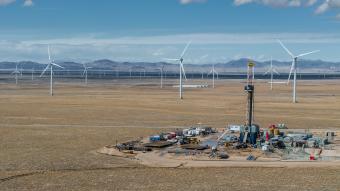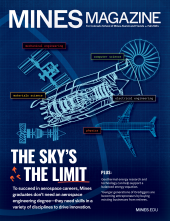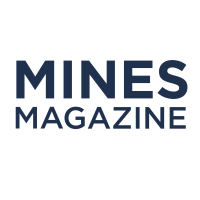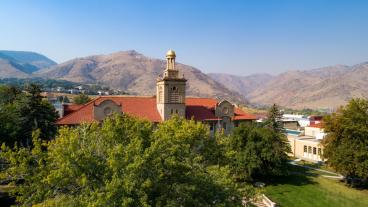Mines alumni working to harness the heat beneath our feet

Fervo Energy’s Cape Station geothermal energy project in southwest Utah aims to deliver around-the-clock carbon-free electricity when it reaches full-scale production in 2028. (Photo courtesy of Fervo Energy)

By Lori Ferguson, Special to Mines Magazine
The desire to realize greater energy independence is an ongoing topic of conversation in the United States and a goal that demands a diverse portfolio of secure and sustainable energy resources. While traditional sources such as oil and gas dominate the energy production market, alternative sources such as wind and solar are increasingly viable. Also in the running: geothermal, a resource the U.S. Department of Energy has characterized as “America’s untapped energy giant.” Research and development initiatives in this sector are surging, and Mines alumni are playing a critical role.
Earth scientist Hunter Knox ’05 is among those who believe deeply in geothermal energy’s potential. A specialist in subsurface investigations, she currently works with the Energy and Environment Directorate of the Department of Energy’s Pacific Northwest National Laboratory (PNNL).
“Geothermal is a 24/7/365 power resource,” Knox said. “Everywhere on earth, the subsurface can provide heat that can be used to generate energy—the sun doesn’t have to shine, and the wind doesn’t have to blow.”
Geothermal energy is also carbon-free—a characteristic that’s increasingly important with efforts to reach a net-zero carbon future—and offers a host of flexible energy solutions. For example, Knox said, a direct-use application of geothermal energy is the installation of heat pumps in homes to reduce energy needs. “By circulating air through the ground, you can keep a home’s air at a certain temperature and make up the temperature difference with conventional heating and cooling methods. This offsets the energy required to keep homes cool in the summer and warm in the winter.”
A second important application of geothermal energy is in power generation. One area of exploration focuses on hydrothermal resources. “In these areas, the trifecta for geothermal naturally exists—heat, water and permeability. This makes it relatively straightforward to extract steam to power turbines,” Knox explained. The other area is enhanced geothermal systems where there is hot rock but no water or natural fractures in the rock. It is here that Knox has focused her research.
“We’re exploring the viability of creating sustainable fractures and running long-term circulation tests that will be vital for successful energy production,” she said.
Knox has spent the last ten years collaborating with colleagues in the Department of Energy’s national laboratory complex on ways to generate these fractures and circulate fluids without triggering a significant earthquake.
“We conduct studies in which we make fractures and then image and monitor them using state-of-the-art hydro-geophysical techniques. In a sense, I’m the doctor who does the CT scan of the geothermal system to make sure all is in order,” she said.
Knox also designs field experiments to validate the Thermal-Hydrological-Mechanical-Chemical (THMC) codes used by modelers to predict the creation of fractures and measure the long-term performance of geothermal reservoirs. “In a nutshell, we execute these experiments to collect data so modelers can improve their codes, making the advancements transferrable to other locations,” she explained.
The research is having an impact, and the technology is advancing at an inspiring pace. In 2023, for example, Houston-based geothermal company Fervo Energy demonstrated that power generation through this process is a viable alternative.
Aleksei Titov ’22 is a senior geophysicist at Fervo and shares Knox’s enthusiasm about the opportunities inherent to this energy source. “Geothermal energy can provide electricity 24/7, it’s renewable and its surface footprint is small,” he said.
An expert in the fields of strain and temperature, Titov focuses his efforts on applying technology to guide reservoir engineering. “In geothermal energy, heat is the resource, and the optimal way to produce this heat is to rely on the stimulation and placement of wells. My research involves using fiber-optic sensing to determine the best models for reservoirs. I listen to the reservoir and translate my findings to the engineering department so that they can optimize reservoir performance across our project portfolio.”
Much research remains to be done, but Knox and Titov assert that Mines alumni are, and will continue to be, key contributors to geothermal energy development, both nationally and internationally.
“It’s an incredibly applied problem, just the type that Mines alumni excel in solving,” Knox said. “As students we’re given lots of opportunities to tackle real-world problems, and in my experience, that increases our passion for research.”
“Mines is one of the best universities in this field,” Titov said. “Nine percent of Fervo’s employees were educated there, including our co-founder and chief technology officer Jack Norbeck MS ’11. We recruit there regularly and enjoy a close working relationship with the university’s faculty and students.”



